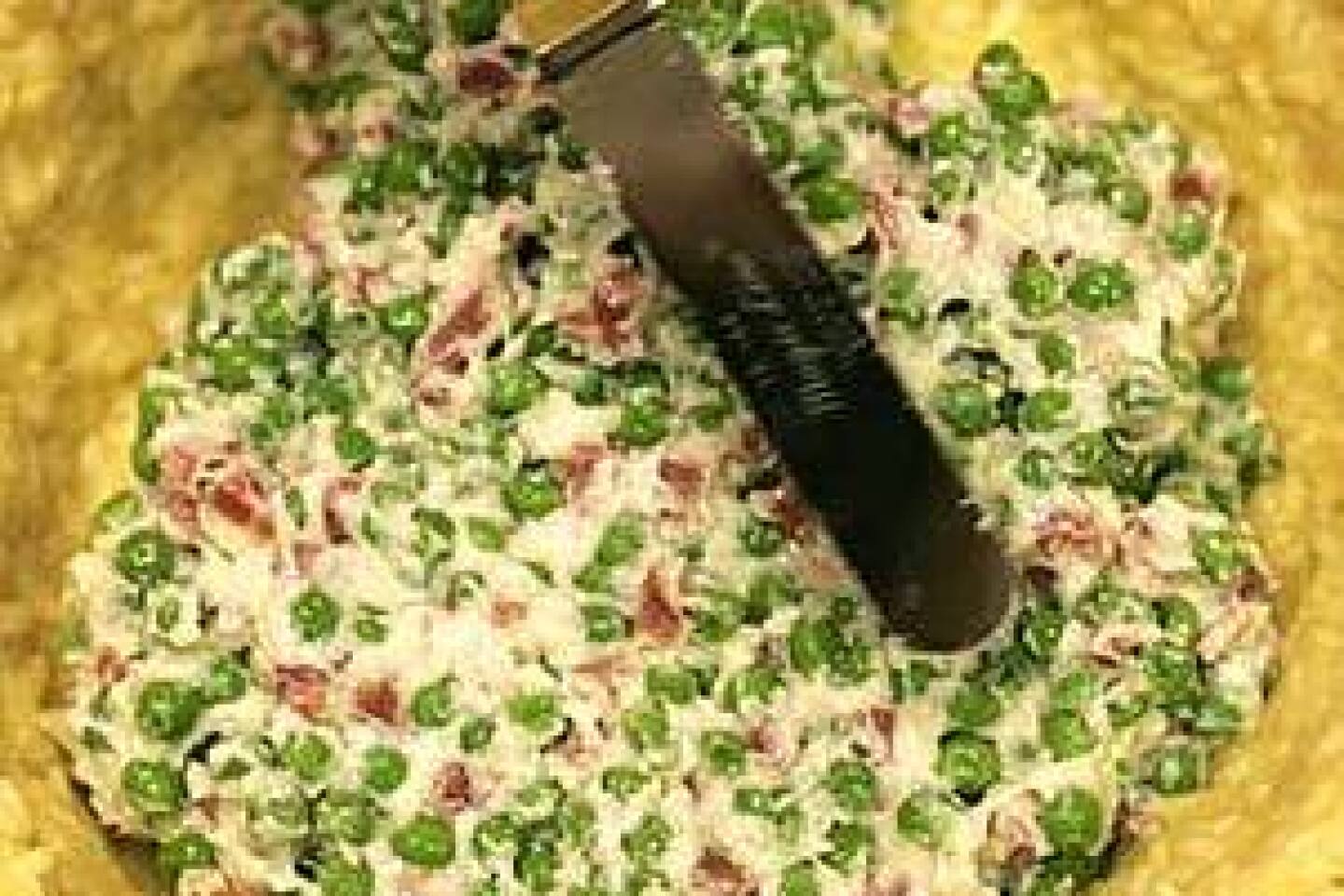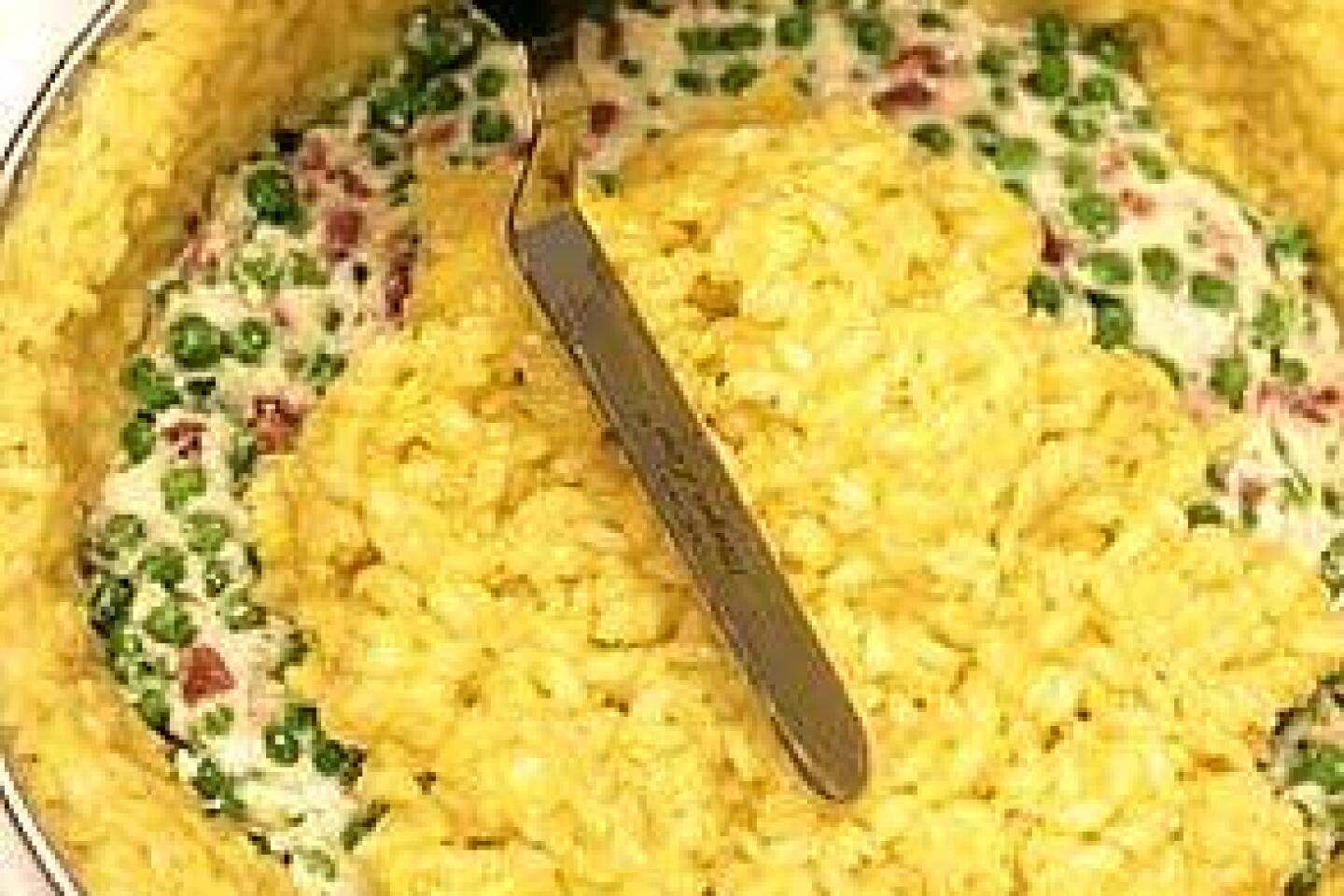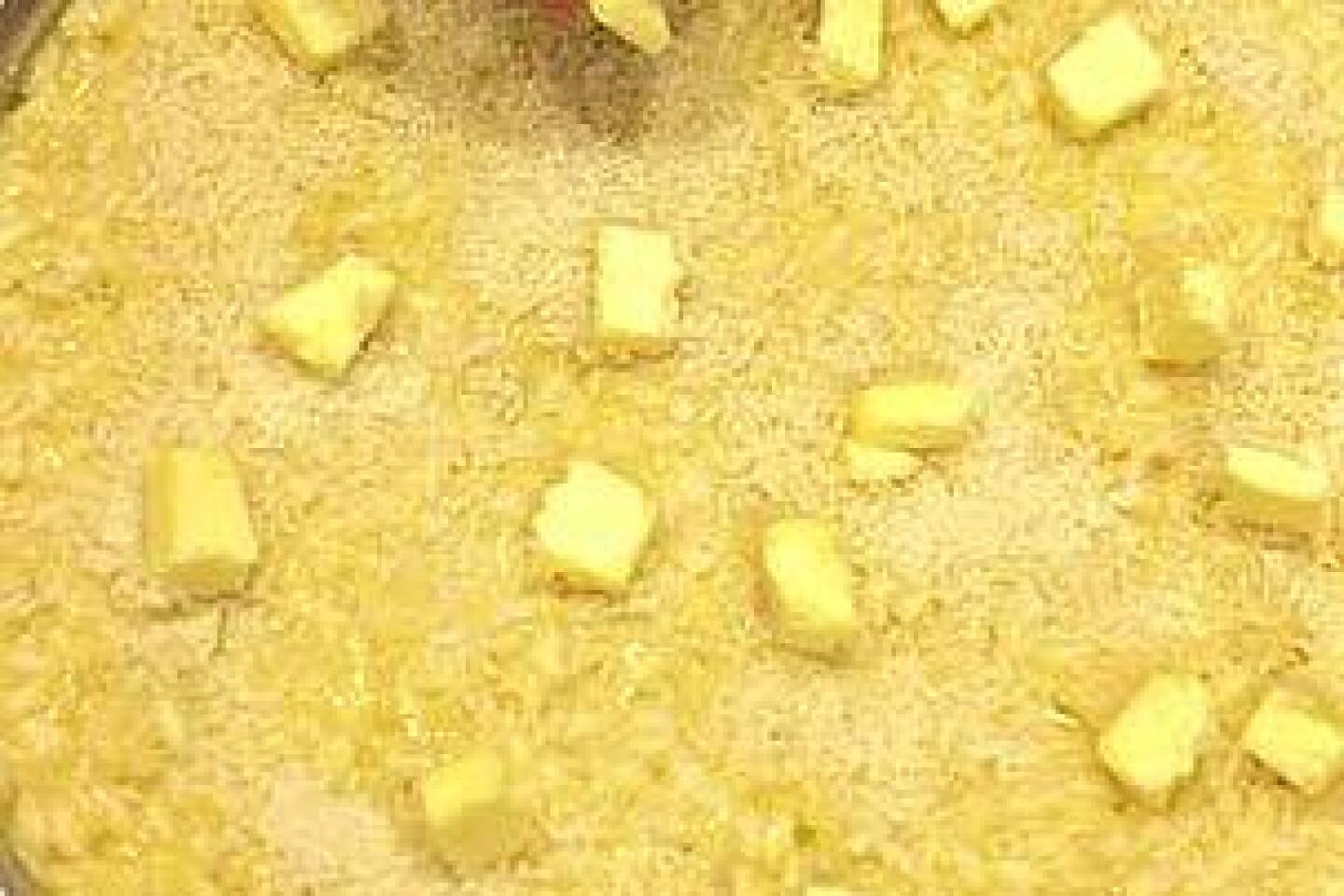With timballo, any night is big
IF there could be any doubt that real life is rarely like the movies, consider the timballo. On screen it is inevitably presented as one dazzling dish about as easy to make as a 15-course meal. In actuality it can be one dazzling dish that is even simpler than lasagna.
The timballo, of course, has been making Americans quail ever since “Big Night,” the 1996 film about two brothers trying to save their restaurant, inspired bad Italian restaurants to start selling gloppy imitations to cash in.
But at one dinner in Parma, Italy, it was vibrantly clear that you can capture the timballo drama without all the histrionics. A big molded dome of crusty risotto on a huge silver platter, this timballo was presented by a white-gloved waiter in an 18th century palazzo, and the air was filled with expectancy when the first guest sank a knife into it. What lay inside was not a complicated mass of froufrou, but a rich combination of peas, ham and Parmigiano that flowed out to enrich the creamy rice.
FOR THE RECORD:
Timballo —An article in Wednesday’s Food section about timballo said the dish was featured in the movie “Big Night.” The pasta creation commonly known as a timballo is referred to as a timpano in the film.
The hosts called their showpiece a bomba (literally “bomb”), but it was really a timballo by another name. And its straightforwardness opened up a whole new way of looking at the dish.
At its simplest, a timballo is pasta, risotto or even mashed potatoes taken one glorious step further to make an entree worthy of a dinner party (especially for vegetarians), or just a great choice for weekend cooking when you want a dish that will keep on giving for another meal or two.
The new “Silver Spoon” cookbook from Italy, published last October by Phaidon, offers a timely overview, with a whole chapter of recipes that strips the timballo down to its brilliant essence: pasta or rice, bound with eggs or cheese and baked into a mold with savory accouterments, including pheasant, pumpkin, giblets, meatballs, mushrooms and/or truffles. The same concept can be adapted to potatoes or even broccoli to stellar effect. And when you mix and match old and new, you can come up with variations that involve sauces, American style.
Hollywood’s vision of a timballo is actually a dish from another era. The preparation dates back to the Renaissance, and a version filled with, among other things, goose, trout and candied orange peel was served at the Medici daughters’ weddings. But perhaps the best-known depiction is of a 19th century assemblage of chicken livers, hard-cooked eggs, sliced ham, chicken and truffles all baked together in a casing of macaroni and pastry in a fragrant, meaty sauce. This timballo had its cinematic moment too, in the 1963 film with Burt Lancaster called “Il Gattopardo” (The Leopard).
*
A mix of names
THE word timballo — Italian from the French timbale — is sometimes translated as a pie, other times as a savory cake. Often it is called a pasticcio, although many references say that word applies only to a similar dish baked in a pastry crust. Sometimes a timballo will be labeled a tortino or a sartu (the Neapolitan interpretation). You could almost consider it a casserole, but that would be undervaluing it, like comparing prosciutto to Spam. For drama, it rivals a soufflé.The Parma dinner party model is simplest to follow, with just rice or pasta bound with eggs and/or cheese and baked into a mold. A special dome is usually used, but a springform pan, the same one you would use for a cheesecake, is easier to unmold without the kind of drama you don’t want: collapsing timballo.
Timballos, to use the English plural, occasionally turn up in restaurants, but they are really the best kind of home cooking. Baked small, as they have to be as an individual entree, they lose their impact. Baked large, they turn into the messiest idea for public consumption, something you have to destroy to enjoy.
To make one, you can start with risotto and add eggs and cheese, layer the mixture over a filling and bake it until it’s set and sliceable. It’s even better than plain risotto for company because it solves the serve-immediately timing problem. Risotto in a timballo will hold together as long as you need it to.
Or you can just boil pasta and make a red sauce, then combine them with lots of cheese to bind the strands and bake the mixture into a cake that is so much more dramatic than the same components served in a bowl.
The only trick is in the mixing. You need to toss and stir really well to get every element evenly incorporated and avoid pockets of blandness and explosions of too-muchness.
The old-fashioned kind of timballo would take a kitchen platoon to assemble, with meats, béchamel, ragù, pasta and pastry all involving complicated steps. Cesare Casella’s “True Tuscan” cookbook includes a relatively streamlined recipe for a “lampshade-sized” Renaissance version that still takes up three pages and, he notes, eats up several days.
*
Regional twists
GIVEN Italy’s short history as a unified country, different regions naturally use different ingredients. Rice is more common in Emilia-Romagna, for instance, where the bomba usually is baked with a filling of pigeon or other game birds as well as peas and local cheese. In the base is dried pasta; in Abruzzo, it can be crepes. Some regions even use ravioli or gnocchi.Anna del Conte’s “Gastronomy of Italy” says that béchamel is one ingredient that is included most consistently in timballos, although they can also be blanketed with mushroom sauce or fonduta, the obscenely rich Piedmontese cheese soup and sauce.
That idea, and her mention of potato timballos, inspired a heart-stopping combination of mashed potatoes thickened with eggs, flavored with shiitakes and sauced with fonduta. A small sliver in a pool of the eggy-cheesy sauce makes an excellent first course but could be dinner. Call it “Big Night” translated as “Italian for Beginners.”
*
Tomato-mozzarella tagliatelle timballo
Total time: 1 hour, 15 minutes plus about 20 minutes cooling
Servings: 8 to 10
3 tablespoons olive oil
4 large cloves garlic, minced
1 (28-ounce) can whole Italian plum tomatoes in purée
1 tablespoon tomato paste
6 anchovies, drained and chopped
1/2 teaspoon crushed red pepper flakes
Salt and pepper to taste
1 pound dried tagliatelle or fettuccine pasta
3 tablespoons butter, divided
1 cup pitted and roughly chopped kalamata olives
3/4 cup freshly grated Parmigiano-Reggiano, divided
2 tablespoons panko or fine dry bread crumbs
12 ounces smoked mozzarella, grated
1. Heat the olive oil in a large skillet over medium heat. Add the garlic and sauté until aromatic, 2 to 3 minutes. Finely crush the tomatoes with your hands and add to the pan along with the purée. Stir in the tomato paste, anchovies and hot red pepper flakes. Season with salt and pepper to taste. Cook, stirring often, 20 minutes.
2. While the sauce cooks, bring a large pot of liberally salted water to a rolling boil. Add the tagliatelle and cook according to package directions until not quite al dente. Drain well and turn into a large bowl. Toss with 2 tablespoons of the butter to keep the noodles from sticking together.
3. Add the tomato sauce, olives and one-half cup Parmigiano-Reggiano to the pasta and mix well to distribute all the ingredients evenly. Set aside until cooled.
4. Heat the oven to 350 degrees. Use the remaining butter to thickly grease a 9-inch springform pan. Dust with the panko, turning to coat the bottom and sides of the pan, shaking off the excess.
5. Add the mozzarella to the tagliatelle and again mix very well to distribute the cheese. Scrape the pasta into the prepared pan, pressing to compact it and smoothing the top. Sprinkle with the remaining Parmigiano-Reggiano.
6. Bake 45 minutes. Let stand 10 minutes. Run a thin spatula around the inside of the rim of the pan to loosen, then remove the spring form. (If any noodles pop out, just gently press them back into the timballo.) Using a very sharp knife, cut into wedges to serve.
Each of 10 servings: 395 calories; 14 grams protein; 40 grams carbohydrates; 2 grams fiber; 19 grams fat; 9 grams saturated fat; 43 mg. cholesterol; 352 mg. sodium.
**Rice timballo with prosciutto and peas
Total time: 1 hour, 45 minutes plus 40 minutes cooling and resting
Servings: 8 to 10
Note: To make a vegetarian version, substitute roasted or sautéed shiitakes for the prosciutto.
11 tablespoons butter, divided
1 large onion, minced
3 large cloves garlic, minced
Coarse sea salt or kosher salt
4 1/2 to 5 cups vegetable or chicken stock
2 cups Carnaroli or Arborio rice
4 tablespoons panko, divided
2 tablespoons flour
1 cup whole milk
1/4 teaspoon freshly grated nutmeg
Pinch cayenne
2 cups freshly grated pecorino Romano, divided
2 cups frozen peas, thawed
4 ounces prosciutto, small dice
5 large eggs, lightly beaten
1. Melt 6 tablespoons butter in a large saucepan over medium heat. Add the onion and garlic and sprinkle with about 1 teaspoon salt. Cook, stirring constantly, until the onions are soft, 5 to 7 minutes. Place the stock in a separate saucepan and bring to a simmer. Add the rice to the saucepan with the butter-onion mixture and stir to coat. Add 1 cup of the stock, increase the heat and cook, stirring, until all the liquid is absorbed. Repeat, adding the remaining stock one cup at a time, and cook until the rice is tender but not soft, about 15 to 18 minutes. Spoon into a large bowl and set aside to cool for about 30 minutes.
2. Heat the oven to 350 degrees. Use 1 tablespoon butter to grease a 9-inch springform pan. Sprinkle with 2 tablespoons of the panko, turning the pan to coat the bottom and sides with the crumbs, shaking off the excess.
3. Make the béchamel sauce: Melt 2 tablespoons butter in a small saucepan over medium heat. Whisk in the flour and cook, stirring, until the mixture is smooth and thickened, about 2 minutes. Add the milk and cook, stirring, until thickened, 3 to 5 minutes. Season with the nutmeg and cayenne and salt to taste. Remove from the heat and stir in 1 cup pecorino Romano cheese. Stir in the peas and the prosciutto; set aside.
5. Add the eggs and the remaining cheese to the rice, mixing very well. Spoon two-thirds of the rice mixture into the prepared pan, pressing it into the bottom and up the sides to the very lip. Spoon the béchamel and pea mixture into the center. Spread the remaining rice over the filling, smoothing the top and sealing the edges to enclose the filling. Sprinkle the remaining panko over the top and dot with the remaining 2 tablespoons butter.
6. Bake 45 minutes, until firm. Heat the broiler and place the pan under the broiler for 30 to 45 seconds to lightly brown the top if desired. Let the timballo stand 10 minutes. Run a spatula around the inside of the rim before removing the springform.
Each of 10 servings: 443 calories; 21 grams protein; 35 grams carbohydrates; 3 grams fiber; 25 grams fat; 14 grams saturated fat; 174 mg. cholesterol; 1,124 mg. sodium.
**Potato timballo with fonduta (cheese sauce)
Total time: 1 1/2 hours plus 2 to 12 hours steeping time
Servings: 10
Note: Adapted from Matt Kramer’s “A Passion for Piedmont”
10 ounces Italian Fontina cheese, cut into small dice
1 1/2 cups whole milk, divided
8 large Yukon gold potatoes
Coarse sea salt or kosher salt
14 tablespoons unsalted
butter, divided
2 cloves garlic, minced
1 pound fresh shiitakes, stemmed, cleaned and diced
1/2 teaspoon tamari or soy sauce
Freshly ground white pepper to taste
6 eggs, lightly beaten
3 to 4 tablespoons panko or fine dry bread crumbs, divided
4 large egg yolks
1. At least 2 hours and preferably the night before, combine the Fontina in a glass bowl with 1 cup of the milk. Let stand (refrigerate if standing more than 2 hours).
2. Peel the potatoes and cut them into chunks. Place in a large pot and cover with cold water. Add about 1 teaspoon salt, cover and bring to a boil. Uncover, then cook until very soft but not mushy, about 20 to 25 minutes. Drain well, then return to the pot. Mash in 4 tablespoons of the butter and the remaining one-half cup milk. Season with one-half teaspoon salt and one-fourth teaspoon pepper or to taste. Spoon into a large bowl and set aside to cool.
3. Heat 4 tablespoons of the butter in a large nonstick skillet over medium heat and add the garlic. Cook 1 to 2 minutes, until aromatic, then add the shiitakes and cook, stirring often, for 10 minutes. Stir in the tamari. Add to the potatoes and mix well. Season liberally with 1 teaspoon salt and one-fourth teaspoon pepper or to taste. Cool slightly, then, using a rubber spatula, fold in the lightly beaten whole eggs until thoroughly blended.
4. Use 1 tablespoon of the butter to thickly grease a 9-by-3-inch springform pan. Dust with 2 tablespoons of the panko to coat the entire interior, shaking out the excess. Spoon the potatoes in the pan, smoothing the top. Sprinkle with enough of the remaining panko to barely cover the top. Dot with 1 tablespoon butter. Bake until firm, about 1 hour.
5. About 15 minutes before the potatoes are done, melt the remaining 4 tablespoons butter in the top of a double boiler or a stainless steel bowl set over gently simmering water in a regular pot. When the butter is completely melted, stir in the Fontina and milk. Whisking constantly, add the egg yolks one at a time. Continue whisking constantly until the cheese is completely melted and the sauce is glossy and thickened to the consistency of hollandaise, 10 to 15 minutes. Remove from the heat as soon as it is done and transfer to a warm bowl.
6. Let the baked timballo stand 10 minutes before running a spatula around the perimeter to unmold. Spoon a generous amount of the fonduta onto small serving plates and top with wedges of the timballo. Serve immediately.
Each serving: 568 calories; 19 grams protein; 54 grams carbohydrates; 5 grams fiber; 31 grams fat; 18 grams saturated fat; 288 mg. cholesterol; 886 mg. sodium.
More to Read
Sign up for our L.A. Times Plants newsletter
At the start of each month, get a roundup of upcoming plant-related activities and events in Southern California, along with links to tips and articles you may have missed.
You may occasionally receive promotional content from the Los Angeles Times.










